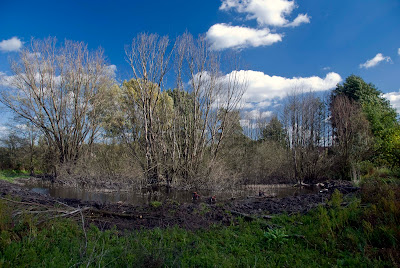Above: Standing on top of a three and half-metre high heap of excavated mud, I can take a photo from a unique point of view that Jeziorki has never afforded before nor will ever do so again. You can see how the diggers have clawed back to the edge of the reed beds. I would guess that the area in the foreground is to be excavated and turned into a large, deep pond. Once connected to proper drainage ditches, this should prevent fields off ul. Kórnicka and the lower end of Trombity from ever flooding again.
Above: the trees that stood to the east of the football pitch have been felled. The contract I referred to a fortnight ago calls for the cutting and removal of exactly 1,691 trees and bushes; there's around 30 in this photo, so these logs represent around 2% of the total that will have to go from this 11-hectare site. Below: a few submerged dead trees, drowned by the floods, have been cut down in the pond between ul. Dumki and Baletowa.
And ul. Dumki, for years, Warsaw's only submerged street - present on city maps yet impassably flooded - is being built up (below). First, builder's rubble has been strewn along the route. A word about health-and-safety here. One can see that the surface is uneven. What's less apparent is the fact that here and there, metal rods and wires, once reinforcing concrete or brickwork, are sticking out.
This is dangerous to passers-by. As I walked here, I was passed by a cyclist and a man on a scooter; an accident waiting to happen, especially at night. This bit of road's not closed (nor should it be), nor are there any warning signs. The builders should take more care than a local pedestrian would need to.
Below: a mound of soil, excavated from out of the marshes, awaiting removal by the side of ul. Kórnicka. In the distance, several piles of hardcore which will be used for road-making. The contract mentions 68,000 cubic metres of soil that will have to be removed; I reckon the mound to the left of this photo is no more than 50 cubic metres, a tiny fraction of the total.
I must say I like what the city planners have done across town in Gocław. There, a pond, locally nicknamed, with some affectionate tongue-in-cheek irony 'Balaton' (after Central Europe's largest lake) has been turned into a highly-popular seven-hectare urban feature, surrounded by footpath and cycle path, with a chic cafe, sports facilities including a beach volleyball court, boats for hire, and the statue to Cyril the Independent Cat. (Take a look at Gocław's Balaton on Google Earth on 52°13'44.39"N, 21° 5'16.37"E, and track back over time all the way to 2000, 1945 and even 1935!)
A water feature like Balaton and the surrounding park are both an admirable investments, but not one that would fit in with Jeziorki's current semi-rural status. The population density here is too low, and besides, this is a wonderful wildlife refuge, which in coming years will be surrounded by creeping urbanisation to the south, the new-build estates of Mysiadło and Nowa Iwiczna and sprawling Piaseczno and Lesznowola beyond.
Let's hope the current works taking place on our wetlands fulfil their goal of preventing a repeat of the floods that have hit local residents and farmers alike, but that ultimately, the place keeps its character and remains home for marsh harriers, herons, swans, ducks, gulls, hares and other wild creatures.
This time last year:
Al. Jerozolimskie - Warsaw's main east-west thoroughfare











2 comments:
Good and interesting post as always.
When I saw the title I was expecting that you had been elected as the first real Sheriff of Jeziorki.
I had visions of you being characterized like the Gary Cooper in the High Noon stylization on the Solidarity posters.
"Get out of town by sunset Chlop!"
Bob
A pond like you describe was created near my home. It does partly fill with water in a wet winter, doing its job. But, more than that, it's formed a splendid little nature reserve with amphibians, birds and so on thriving. In summer children play there and it's a good place to walk dogs too.
Post a Comment